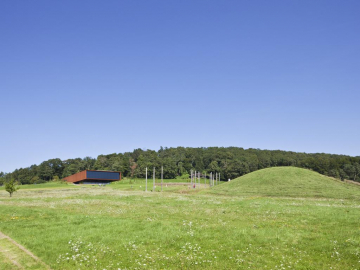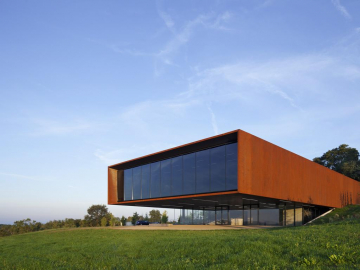Celtic Museum
The CELTIC MUSEUM merges into the spacious landscape as a clearly contoured and distinct structure. Half concealed in the slope, it is oriented to the Celtic mound. The protected space under the mighty overhang serves as the start and end point of the tour on the archaeological trail and for the exploration of the museum. The closed volume provides an exhibition situation that does justice to the light-sensitive exhibits and allows visitors to completely immerse themselves in the Celtic world.
SCENOGRAPHY The architecture of the exhibition is based on the superordinate principle of layering, inspired by the procedures of an archaeological excavation. Differently shaped horizontal, vertically layered bands, projecting and receding, form changeable exhibits. These offer various presentation options and permit the integration of flat showcases, media stations, and glass display cabinets. There is no strict route to be followed, but rather an open, flexible exhibition concept bringing together the various aspects of the Celtic world.
MATERIAL AND CONSTRUCTION The compact form is supported by a casing of large-format Corten steel plates. On the one hand, the material evokes associations with earthiness, and on the other a reminiscence of the Celts artistic handling of metals. The rooms are as far as possible column-free thanks to six-metre-high steel frameworks in the closed side walls. The anchorage is a conventional solid reinforced concrete construction. (plot size: 19,350 m², building size (gfa): 2,190 m²)
SUSTAINIBILITY The compact building form and low surface area of the museum reduces the primary energy requirement and seals only a small area of the landscape. The ventilated metal façade of Corten steel represents an optimal energy standard, permanently protects the construction and minimises operating expenses due to a lack of ongoing maintenance costs. Highly insulating, recyclable building materials and thermal insulation glazing also contribute to cost reduction.









.jpg)